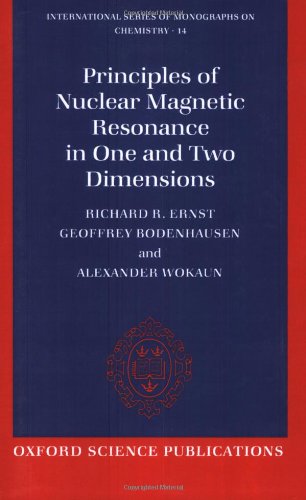Principles of nuclear magnetic resonance in one and two dimensions pdf download
Par vaughn concetta le mercredi, juin 1 2016, 15:59 - Lien permanent
Principles of nuclear magnetic resonance in one and two dimensions. Alexander Wokaun, Geoffrey Bodenhausen, Richard R. Ernst

Principles.of.nuclear.magnetic.resonance.in.one.and.two.dimensions.pdf
ISBN: 0198556292,9780198556299 | 713 pages | 18 Mb

Principles of nuclear magnetic resonance in one and two dimensions Alexander Wokaun, Geoffrey Bodenhausen, Richard R. Ernst
Publisher: Clarendon Press
Principles of Nuclear Magnetic Resonance in One and Two Dimensions by Richard R. Phase cycling consists of repeating the same sequence of RF pulses two or more times while changing the phase(s) of one or more RF pulses and/or the receiver phase (Ernst et al., Principles of Nuclear Magnetic Resonance in One and Two Dimensions, Clarendon, Oxford (1987)). Additionally, two-dimensional 1HH-NMR and CH-NMR (COSY spectra) were performed for identification of neighbouring hydrogens by cross peaks. The effectiveness of NMR can also be improved using hyperpolarization, and/or using two-dimensional, three-dimensional and higher dimension multi-frequency techniques. The high Q2 value indicates the high predictive capabilities for the model. The present invention discloses a method of simultaneously conducting more than one step of a radiofrequency phase cycle in a nuclear magnetic resonance (NMR) experiment. Background: The Y145Stop prion protein is a useful model for understanding basic principles of amyloid formation. Using two-dimensional and three -dimensional solid-state NMR methods, we find that Δ113–120 PrP23–144 fibrils contain an altered β-core extended N-terminally to residue ∼106, encompassing residues not present in the core of wild-type PrP23–144 fibrils. In rabbit hearts, neither a decrease in dispersion nor an increase in the percentage of potential duration within the ±5 ms interval around the mean ARI was found (control 66.3±3.5%, 1 nmol/L AAP8TT 66.0±2.6%, 100 nmol/L AAP8TT 64.3±3.9%). My general feeling is that it would be tricky to award a Nobel for solids NMR without including Alex Pines (Berkeley), as he's had his hand in the development of cross polarization (which basically everyone uses, whether you're doing static solids NMR or magic angle spinning solids NMR), as well as contributing to multiple-quantum NMR I don't know enough details about Bax's work to single out one or two specific contributions so I will leave it to you to point it out. Where CS is chemical shift (ppm), T is temperature and dT=15°C. NMR Imaging of Materials by Bernhard Blümich Discusses: surface relaxivity; Modern Magnetic Resonance - Part 1: Applications in Chemistry. �1 Present address: Department of Chemistry, University of Washington, Seattle, WA 98195.
Theories Of Nationalism: A Critical Introduction pdf free